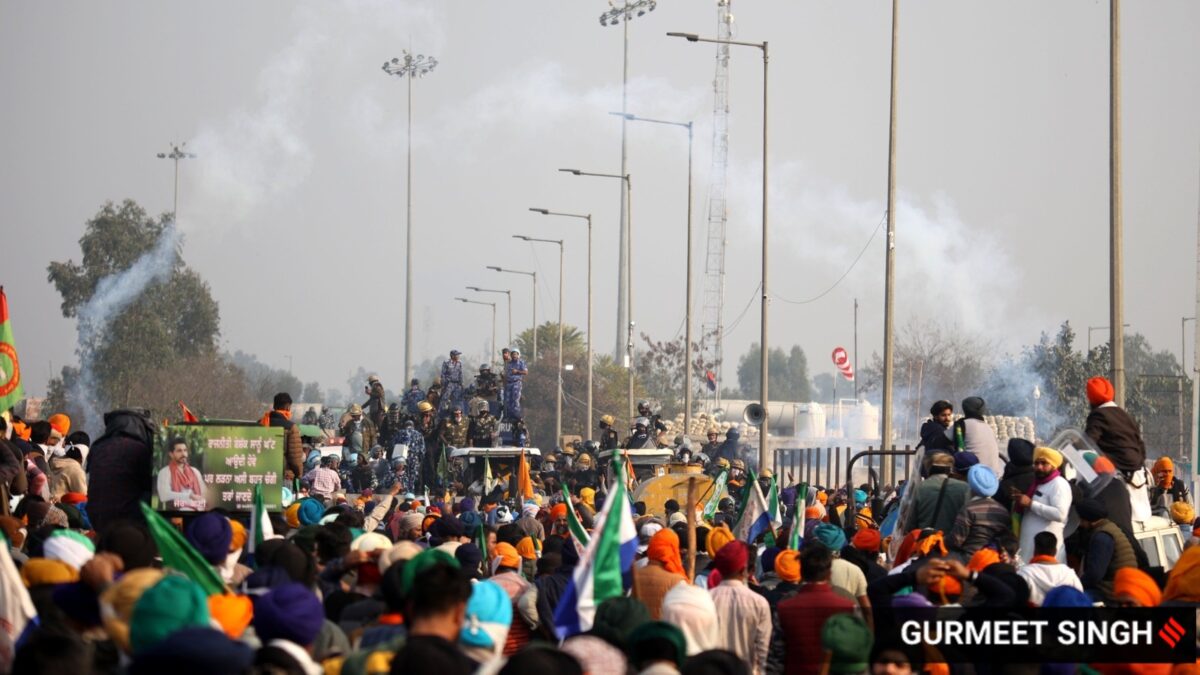Table of Contents
With people wearing anti-riot gear and concrete barricades controlling access to various roads, Delhi is heavily fortified. Again the situation lead to farmer protest against the government lead to Delhi Chalo 2.0.
Farmers protesting on behalf of different farmer unions will march on the nation’s capital on Wednesday. Currently, in response to the farmers’ “Delhi chalo” call, the Delhi Police stationed at the borders are keeping an eye on the borders and making sure that law and order is maintained.
The boundaries of the national capital at Singhu, Tikri, and Ghazipur are sealed by a massive paramilitary and police force in addition to several layers of barricading.Heavy security has been placed over Central Delhi, with anti-riot gear-wearing policemen stationed strategically and concrete and metal barricades controlling access to a number of important roadways.
In light of the farmers’ march towards the nation’s capital on Tuesday, the Delhi Metro restricted traveller admission and departure at nine stations by closing some gates for a number of hours.
Thousands of farmers were seeking minimum crop prices, and after talks with the government failed, police used tear gas to stop them from marching towards New Delhi, the capital. At the Shambhu border in Ambala, some 200 kilometres north of the capital, demonstrators were scattered by thick clouds of tear gas. In addition, tear gas canisters were dropped from the air by police using drones.
The Punjab state police force has been ordered to remain on duty in the field, making up about 70% of the force, despite the fact that the police are not actively preventing farmers from the state from moving towards Delhi.

What demands do farmers have, and why are they protesting?
The farmers want the Centre to accept their list of requests, therefore they are putting on a massive protest. In order to fulfil their agreement to cease their protest against the now-repealed agricultural regulations in 2021, the farm organisations specified that legislation ensuring a minimum support price (MSP) would be necessary.
The farmers are also demanding the implementation of the recommendations made by the Swaminathan Commission, pensions for farmers and agricultural labourers, and the cancellation of farm debt. Farmers claim that the Centre should provide “justice” for those who were harmed in Lakhimpur Kheri.
Farmers’ Protest: Nine Delhi Metro Stations’ Multiple Gates Are Shut:
On Tuesday morning, one or more gates at eight Delhi Metro stations were closed in anticipation of the farmers’ march to the nation’s capital. Passengers are still able to enter and exit these stations using other gates because they are open.
According to official sources, the gates have been closed for security reasons per police authority orders.
According to a senior official, many gates have been closed at a number of stations, including Lok Kalyan Marg, Barakhamba Road, Janpath, Khan Market, Central Secretariat, Rajiv Chowk, Udyog Bhawan, Patel Chowk, and Mandi House.
The officer said that on Tuesday, a gate at the Khan Market metro station was also closed.
The frontiers of the nation’s capital are sealed by a massive deployment of law enforcement and paramilitary forces in addition to several layers of barricading.
Five main differences between the farmers’ protest in 2020 and the farmers’ protest in 2.0:
1. Why farmers are currently protesting:
Farmers protested three laws in 2020; a year later, the laws were abolished on the borders of Delhi as a result of their actions.
When Delhi Chalo was planned in 2023, the demands included a legal guarantee of MSP for all crops, the application of the Swaminathan Commission’s formula, the complete cancellation of farmer debt, pensions for labourers and farmers, and the dismissal of prosecutions brought against farmers during the 2020–21 protest.
2. Who is the protest’s leader?
The farmers’ union environment has transformed over the past few years, and various unions are leading the charge on Farmers Protest 2.0.
Delhi Chalo 2.0 has been launched by both the Kisan Mazdoor Morcha and the Samyukt Kisan Morcha (Non-Political).
The Bhartiya Kisan Union and Samyukt Kisan Morcha, which led the farmers’ protest in 2020, experienced factionalism.
3. Delhi Chalo 2.0 does not include Gurnam Singh Charuni and Rakesh Tikait:
Gurnam Singh Charuni and Rakesh Tikait were the two well-known leaders of the 2020 farmers’ protest. However, when the farmers hit the streets four years later, they are nowhere to be seen. These days, the front-runners are Kisan Mazdoor Morcha (KMM) general secretary Sarwan Singh Pandher and non-political SKM leader Jagjit Singh Dallewal.
4. Massive security and blockades prevent farmers from reaching Delhi:
Farmers were allowed to enter the nation’s capital in 2020, but this time around the administration has implemented stringent preventive procedures. Roads to Delhi are all blocked by barbed wire, cement barricades, and nails in the pavement. Delhi has implemented Section 144. Punjabi borders were blocked by the government of Haryana.
5. Government response :
This time around, the government began the negotiation process before to the farmers’ Delhi Chalo march. On February 8, the Union ministries and the leaders of the farmers met for the first time. The date of the second meeting was February 12.
There was no legal assurance of MSP, but reports state that the government agreed to drop all proceedings against farmers filed during the 2020–21 protests against the now-repeated farm laws.
Also Read: Bhool Bhulaiyaa 3: Kartik Aryan and Vidya Balan Crossover




1 Comment
Pingback: Pulwama Attack: 5 years of Terrorist Attack